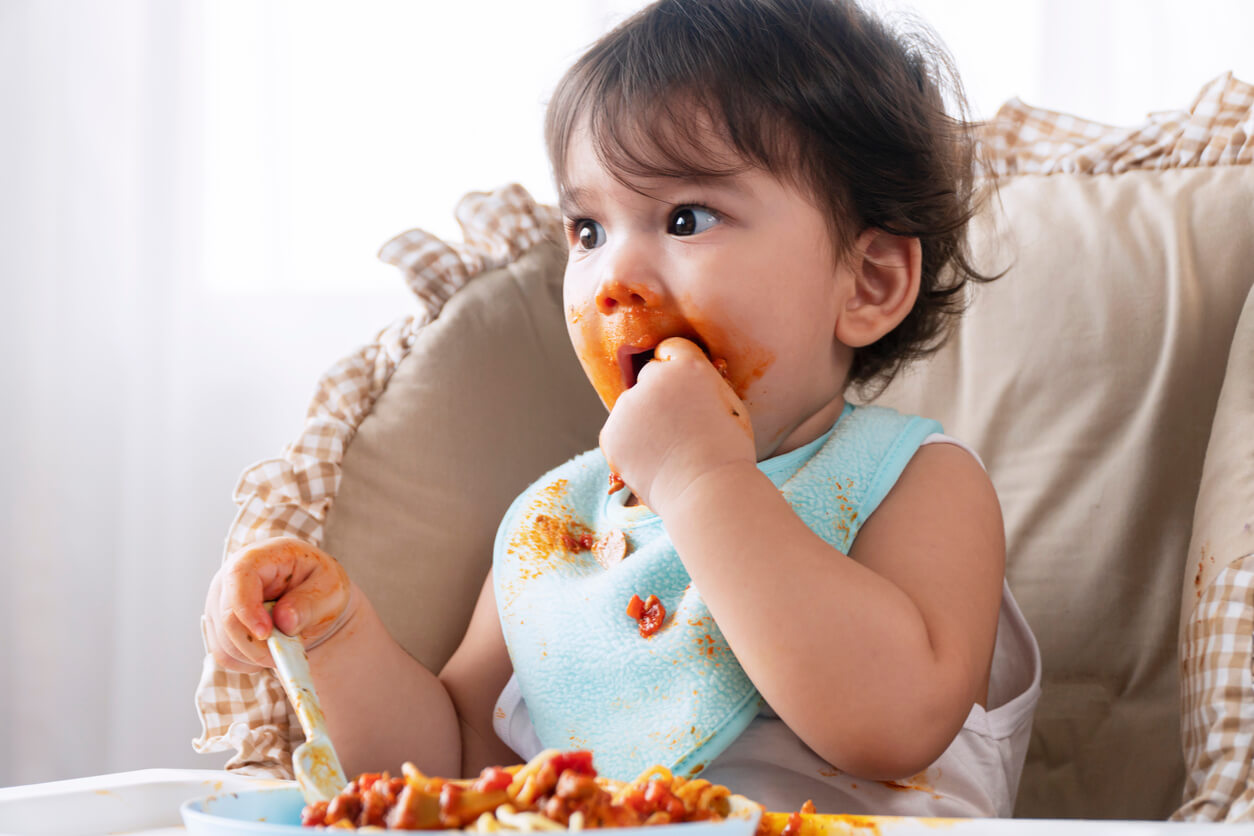3 Benefits of Intuitive Eating in Children and How to Apply It


Written and verified by the psychologist Elena Sanz Martín
Feeding children is one of the issues that most concern parents. As adults in charge of them, we want children to have a healthy intake, to develop a good relationship with food, and not to lack any nutrients. We’re also concerned about preventing childhood obesity and food crazes, but we don’t always know how to achieve these goals. Fortunately, knowing about intuitive eating in children can help us.
The premise is simple: Feeding is a natural and physiological act. Therefore, the body possesses the signals to help us do it properly. It’s only when we get in its way that this natural path is truncated and we fall into certain mistakes and bad habits. So, if you want to encourage your child’s feeding, it’s important that you allow yourself to trust their instincts and teach them to listen to their body’s sensations.
What is intuitive eating in children?
The concept of intuitive eating was proposed in 1995 by American dietitians Evelyn Tribole and Elyse Resch. It invites us to move away from rigid rules and external impositions when it comes to feeding ourselves. On the other hand, it invites us to make conscious and respectful choices according to our body’s signals.
What does this mean? It means that we’ll have to listen to ourselves to know what we need at each moment. Am I really hungry or am I just bored? Do I want to eat more or do I already feel satiated? What foods do I feel like or does my body ask for at this moment? Do I feel hungry now or is it better to wait? All these questions are very simple and necessary, but we rarely ask ourselves them.
On the contrary, we submit ourselves to rigid eating schedules set from the outside, forcing ourselves to eat a certain amount of food, even if it fills us up too much or leaves us hungry. And we often use food to escape from difficult emotions. The worst thing is that we do the same with our children: We disconnect them from their body’s signals and make the moment of eating something forced, imposed, and unnatural.
What are the benefits of intuitive eating in children?
Practicing intuitive nutrition with little ones has multiple advantages for their health and development, both physical and emotional. These are some of the most relevant.

1. It promotes a good relationship with food
The main task that parents should address regarding food isn’t so much to ensure that their children eat what they should eat. On the contrary, it’s to promote a good relationship with food. And it’s this last aspect that will bring them ease and benefits for life. In this regard, we must help children to see food as their body’s fuel, as something they eat to take care of themselves, feel good, have energy, and be healthy.
Many times, mealtimes can feel like torture for children. This happens because they’re forced to eat, they’re pressured and scolded, or because, even at very young ages, they’re worried about getting fat or how their figure looks. In contrast, intuitive eating helps to avoid these situations.
Specifically, a study published in the American Journal of Health Education found that intuitive eating is related to a greater ability to enjoy food and feel pleasure in these nutritional moments.
2. It prevents obesity
This nutritional approach is also helpful in preventing childhood obesity and helping children maintain a healthy weight. It helps them to choose the most beneficial foods for their bodies and to nourish themselves according to what they need.
In the aforementioned work, it was found that intuitive eating is associated with a lower body mass index. In addition, other research suggests that programs that include this type of nutrition facilitate weight loss and healthy food choices. They may even help improve insulin resistance and prevent diabetes in children and adolescents.
3. Helps prevent eating disorders
Another favorable point of this nutrition model is that it protects children from developing eating disorders (EDs). By moving away from restrictions, guilt, and impositions, we prevent children from engaging in dieting behaviors and suffering from anxieties. It can even be an important element in recovery from an ED and relapse prevention.
Keep reading: The 2 Main Eating Disorders in Children
How to apply intuitive eating in children?
Now that you know the great benefits of intuitive nutrition, we want to propose some guidelines for you to start implementing it with your children. Remember that the sooner you apply this approach, the easier it’ll be for them to absorb its principles.
Teach them to listen to their body’s signals
From birth, little ones are very connected to their body sensations and easily know when they’re hungry and when they’re full. Listen to and respect those signals and teach your child to do the same. This means not forcing them to eat or forcing them to finish a plate if they’re full. Even if you take routines and quantities as a basis, be flexible to adapt them to the child’s signals and needs.

Present all foods in a neutral way
Many times, parents themselves demonize certain foods and sanctify others. For example, when we prohibit eating sweets or offer them as a reward in exchange for eating vegetables. This only makes children crave sweets even more and perceive healthy foods as unappetizing or an imposition.
To avoid this, you can offer all kinds of foods in regular meals with balance and allow your child to manipulate them. That way, they’ll learn to self-regulate easily.
Find out more: No More Mashed Foods: The Benefits of Baby Led-Weaning
Don’t force your child to eat
It’s normal for children to refuse certain foods, especially if they’re new to them. But, even if they must eat them, forcing them to do so isn’t the best option because it’ll create tension, pressure, and stress. Therefore, it’s preferable to look for other methods, such as presenting meals in a more appealing and appetizing way, or exposing them repeatedly to a food so that they become familiar with it at their own pace.
Make mealtimes a relaxed and pleasant moment
It’s very important that mealtimes be a safe, relaxed, and pleasant space for children. Therefore, avoid arguments at that time and dedicate it to lively conversation with your children. Also, turn off the TV and put aside cell phones and other electronic devices.
Disassociate food from emotions
Finally, try not to create an association between food and emotions. This means that we shouldn’t teach children to cope with negative emotions with a food they like. Many times, we offer them those “forbidden” foods when they’re sick, sad, or irritated, as a way to comfort them, but this isn’t a good strategy.
It’s preferable to show them other techniques to regulate themselves emotionally and offer them comfort with a hug, conversation, or a fun activity. Food shouldn’t become their outlet for discomfort.
The key is health
If you want to practice intuitive eating with children, remember to focus on health and not body image. Avoid repeating messages about which foods are fattening or slimming and convey to them what benefits each product has for their body and well-being. Also encourage them to practice sports, breathing, or meditation.
When a child learns to love their body as the vehicle of their soul, they’re more likely to take care of it and treat it well. In this society obsessed with beauty standards, diets, and restrictions, learning to eat with awareness and respect for the body is an excellent protection tool for their mental health.
Feeding children is one of the issues that most concern parents. As adults in charge of them, we want children to have a healthy intake, to develop a good relationship with food, and not to lack any nutrients. We’re also concerned about preventing childhood obesity and food crazes, but we don’t always know how to achieve these goals. Fortunately, knowing about intuitive eating in children can help us.
The premise is simple: Feeding is a natural and physiological act. Therefore, the body possesses the signals to help us do it properly. It’s only when we get in its way that this natural path is truncated and we fall into certain mistakes and bad habits. So, if you want to encourage your child’s feeding, it’s important that you allow yourself to trust their instincts and teach them to listen to their body’s sensations.
What is intuitive eating in children?
The concept of intuitive eating was proposed in 1995 by American dietitians Evelyn Tribole and Elyse Resch. It invites us to move away from rigid rules and external impositions when it comes to feeding ourselves. On the other hand, it invites us to make conscious and respectful choices according to our body’s signals.
What does this mean? It means that we’ll have to listen to ourselves to know what we need at each moment. Am I really hungry or am I just bored? Do I want to eat more or do I already feel satiated? What foods do I feel like or does my body ask for at this moment? Do I feel hungry now or is it better to wait? All these questions are very simple and necessary, but we rarely ask ourselves them.
On the contrary, we submit ourselves to rigid eating schedules set from the outside, forcing ourselves to eat a certain amount of food, even if it fills us up too much or leaves us hungry. And we often use food to escape from difficult emotions. The worst thing is that we do the same with our children: We disconnect them from their body’s signals and make the moment of eating something forced, imposed, and unnatural.
What are the benefits of intuitive eating in children?
Practicing intuitive nutrition with little ones has multiple advantages for their health and development, both physical and emotional. These are some of the most relevant.

1. It promotes a good relationship with food
The main task that parents should address regarding food isn’t so much to ensure that their children eat what they should eat. On the contrary, it’s to promote a good relationship with food. And it’s this last aspect that will bring them ease and benefits for life. In this regard, we must help children to see food as their body’s fuel, as something they eat to take care of themselves, feel good, have energy, and be healthy.
Many times, mealtimes can feel like torture for children. This happens because they’re forced to eat, they’re pressured and scolded, or because, even at very young ages, they’re worried about getting fat or how their figure looks. In contrast, intuitive eating helps to avoid these situations.
Specifically, a study published in the American Journal of Health Education found that intuitive eating is related to a greater ability to enjoy food and feel pleasure in these nutritional moments.
2. It prevents obesity
This nutritional approach is also helpful in preventing childhood obesity and helping children maintain a healthy weight. It helps them to choose the most beneficial foods for their bodies and to nourish themselves according to what they need.
In the aforementioned work, it was found that intuitive eating is associated with a lower body mass index. In addition, other research suggests that programs that include this type of nutrition facilitate weight loss and healthy food choices. They may even help improve insulin resistance and prevent diabetes in children and adolescents.
3. Helps prevent eating disorders
Another favorable point of this nutrition model is that it protects children from developing eating disorders (EDs). By moving away from restrictions, guilt, and impositions, we prevent children from engaging in dieting behaviors and suffering from anxieties. It can even be an important element in recovery from an ED and relapse prevention.
Keep reading: The 2 Main Eating Disorders in Children
How to apply intuitive eating in children?
Now that you know the great benefits of intuitive nutrition, we want to propose some guidelines for you to start implementing it with your children. Remember that the sooner you apply this approach, the easier it’ll be for them to absorb its principles.
Teach them to listen to their body’s signals
From birth, little ones are very connected to their body sensations and easily know when they’re hungry and when they’re full. Listen to and respect those signals and teach your child to do the same. This means not forcing them to eat or forcing them to finish a plate if they’re full. Even if you take routines and quantities as a basis, be flexible to adapt them to the child’s signals and needs.

Present all foods in a neutral way
Many times, parents themselves demonize certain foods and sanctify others. For example, when we prohibit eating sweets or offer them as a reward in exchange for eating vegetables. This only makes children crave sweets even more and perceive healthy foods as unappetizing or an imposition.
To avoid this, you can offer all kinds of foods in regular meals with balance and allow your child to manipulate them. That way, they’ll learn to self-regulate easily.
Find out more: No More Mashed Foods: The Benefits of Baby Led-Weaning
Don’t force your child to eat
It’s normal for children to refuse certain foods, especially if they’re new to them. But, even if they must eat them, forcing them to do so isn’t the best option because it’ll create tension, pressure, and stress. Therefore, it’s preferable to look for other methods, such as presenting meals in a more appealing and appetizing way, or exposing them repeatedly to a food so that they become familiar with it at their own pace.
Make mealtimes a relaxed and pleasant moment
It’s very important that mealtimes be a safe, relaxed, and pleasant space for children. Therefore, avoid arguments at that time and dedicate it to lively conversation with your children. Also, turn off the TV and put aside cell phones and other electronic devices.
Disassociate food from emotions
Finally, try not to create an association between food and emotions. This means that we shouldn’t teach children to cope with negative emotions with a food they like. Many times, we offer them those “forbidden” foods when they’re sick, sad, or irritated, as a way to comfort them, but this isn’t a good strategy.
It’s preferable to show them other techniques to regulate themselves emotionally and offer them comfort with a hug, conversation, or a fun activity. Food shouldn’t become their outlet for discomfort.
The key is health
If you want to practice intuitive eating with children, remember to focus on health and not body image. Avoid repeating messages about which foods are fattening or slimming and convey to them what benefits each product has for their body and well-being. Also encourage them to practice sports, breathing, or meditation.
When a child learns to love their body as the vehicle of their soul, they’re more likely to take care of it and treat it well. In this society obsessed with beauty standards, diets, and restrictions, learning to eat with awareness and respect for the body is an excellent protection tool for their mental health.
All cited sources were thoroughly reviewed by our team to ensure their quality, reliability, currency, and validity. The bibliography of this article was considered reliable and of academic or scientific accuracy.
- Kristeller, J. L., & Epel, E. (2014). Mindful eating and mindless eating: The science and the practice. In A. le, C. T. Ngnoumen, & E. J. Langer (Eds.), The Wiley Blackwell handbook of mindfulness (pp. 913–933). Wiley Blackwell. https://doi.org/10.1002/9781118294895.ch47
- Koller, K. A., Thompson, K. A., Miller, A. J., Walsh, E. C., & Bardone‐Cone, A. M. (2020). Body appreciation and intuitive eating in eating disorder recovery. International Journal of Eating Disorders, 53(8), 1261-1269. https://onlinelibrary.wiley.com/doi/abs/10.1002/eat.23238
- Linardon, J. (2021). Positive body image, intuitive eating, and self‐compassion protect against the onset of the core symptoms of eating disorders: A prospective study. International Journal of Eating Disorders, 54(11), 1967-1977.
- Tribole, E., & Resch, E. (1995). Intuitive eating: a recovery book for the chronic dieter: rediscover the pleasures of eating and rebuild your body image.
- Singh, N. N., Lancioni, G. E., Singh, A. N., Winton, A. S., Singh, J., McAleavey, K. M., … & Joy, S. D. (2008). A mindfulness-based health wellness program for managing morbid obesity. Clinical Case Studies, 7(4), 327-339.
- Shomaker, L. B., Bruggink, S., Pivarunas, B., Skoranski, A., Foss, J., Chaffin, E., … & Bell, C. (2017). Pilot randomized controlled trial of a mindfulness-based group intervention in adolescent girls at risk for type 2 diabetes with depressive symptoms. Complementary therapies in medicine, 32, 66-74.
- Smith, T., & Hawks, S. R. (2006). Intuitive eating, diet composition, and the meaning of food in healthy weight promotion. American Journal of Health Education, 37(3), 130-136.
This text is provided for informational purposes only and does not replace consultation with a professional. If in doubt, consult your specialist.








